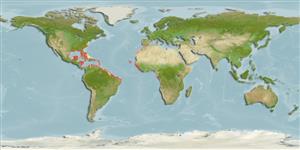Environment: milieu / climate zone / depth range / distribution range
Ökologie
seewasser; brackwasser riff-verbunden; tiefenbereich 0 - 5 m (Ref. 3723). Subtropical; 41°N - 13°S, 98°W - 14°E
Western Atlantic: New York, USA and northern Gulf of Mexico to Brazil (Ref. 7251); including the Caribbean Sea (Ref. 3723). Eastern Atlantic: from Morocco to the Canary Islands (Ref. 57227) and in the Gulf of Guinea from Victoria, Nigeria to south to Luanda, Angola (Ref. 4497). Reported from Côte d'Ivoire (Ref. 28587, 57227).
Size / Gewicht / Alter
Maturity: Lm ? range ? - ? cm
Max length : 40.0 cm TL Männchen/unbestimmt; (Ref. 3633); common length : 35.0 cm TL Männchen/unbestimmt; (Ref. 3633)
Rückenflossenstacheln (insgesamt) : 0; Rückenflossenweichstrahlen (insgesamt) : 11 - 15; Afterflossenstacheln: 0; Afterflossenweichstrahlen: 10 - 13. Diagnosis: body elongate; lower jaw forming long, narrow beak; upper jaw short, triangular and scaled; absence of scales on snout; no preorbital crest between eye and nasal pit; pelvic fins abdominal; dorsal and anal fins placed far back on body and spineless; caudal fin deeply forked (Ref. 57227).
An inshore, surface-dwelling fish which forms sizeable schools (Ref. 3723). Feeds on small fishes and plankton (Ref. 3723). Mainly used as bait for offshore game fishes such as sailfishes and marlins; utilized as a food fish in the West Indies (Ref. 3723). Minimum depth range from Ref. 84211.
Life cycle and mating behavior
Maturities | Fortpflanzung | Spawnings | Egg(s) | Fecundities | Larven
Collette, B.B. and N.V. Parin, 1990. Hemiramphidae. p. 579-582. In J.C. Quero, J.C. Hureau, C. Karrer, A. Post and L. Saldanha (eds.) Check-list of the fishes of the eastern tropical Atlantic (CLOFETA). JNICT, Lisbon; SEI, Paris; and UNESCO, Paris. Vol. 2. (Ref. 4497)
IUCN Rote Liste Status (Ref. 130435)
Bedrohung für Menschen
Harmless
Nutzung durch Menschen
Fischereien: weniger kommerziell; Köder: usually
Tools
Zusatzinformationen
Download XML
Internet Quellen
Estimates based on models
Preferred temperature (Ref.
123201): 21.1 - 28.1, mean 27.2 °C (based on 1007 cells).
Phylogenetic diversity index (Ref.
82804): PD
50 = 0.5005 [Uniqueness, from 0.5 = low to 2.0 = high].
Bayesian length-weight: a=0.00339 (0.00169 - 0.00679), b=3.09 (2.92 - 3.26), in cm total length, based on LWR estimates for this species & Genus-body shape (Ref.
93245).
Trophic level (Ref.
69278): 3.9 ±0.3 se; based on diet studies.
Widerstandsfähigkeit (Ref.
120179): hoch, Verdopplung der Population dauert weniger als 15 Monate. (Preliminary K or Fecundity.).
Fishing Vulnerability (Ref.
59153): Low to moderate vulnerability (30 of 100).
Nutrients (Ref.
124155): Calcium = 79.2 [27.5, 252.2] mg/100g; Iron = 0.831 [0.317, 2.037] mg/100g; Protein = 19.3 [16.7, 21.8] %; Omega3 = 0.188 [0.071, 0.570] g/100g; Selenium = 15.3 [5.2, 42.4] μg/100g; VitaminA = 27.3 [5.6, 150.6] μg/100g; Zinc = 1.02 [0.54, 1.80] mg/100g (wet weight);
